A Topology Optimization Method for Reducing Communication Overhead in the Kalman Consensus Filter
Abstract
:Featured Application
Abstract
1. Introduction
- The problem of communication overhead reduction in the KCF algorithm is converted into the optimization of network topology, which achieves a good trade-off between the mean square estimate error and network communication overhead.
- A network topology optimization method is proposed according to nodes’ local structural parameters information, in which the constraint on the communication range of two nodes is incorporated.
2. System Model and Problem Formulation
2.1. Network Model
2.2. Kalman Consensus Filter Algorithm
2.3. Problem Formulation
3. Network Topology Optimization Method
3.1. The Structural Parameters of Network Topology
3.2. Network Topology Optimization Method
| Algorithm 1: A network topology optimization method according to local nodes’ topology parameter information. |
| Input: original network topology , the number of nodes I, the number of communication links K, the communication range of network D. 1: initialize the number of optimization adjustment, b = 0. 2: while && do 3: select node i from set randomly 4: determine using operations (3)–(7) 5: delete link (a, b) determined in operation (7) 6: update and 7: select node p from set randomly 8: determine using operations (8)–(12) 9: add link (c, d) determined in operation (12) 10: update and 11: b = b + 1 12: end while Output: optimized network topology . |
3.3. Performance Analysis
4. Performance Evaluation and Discussion
5. Conclusions
Author Contributions
Funding
Institutional Review Board Statement
Informed Consent Statement
Data Availability Statement
Conflicts of Interest
References
- Akyildiz, I.; Su, W.; Sankarasubramaniam, Y.; Cayirci, E. Wireless sensor networks: A survey. Comput. Netw. 2002, 38, 393–422. [Google Scholar] [CrossRef] [Green Version]
- Dai, S.; Jing, X.; Li, L. Research and analysis on routing protocols for wireless sensor networks. In Proceedings of the 2005 International Conference on Communications, Circuits and Systems, Hong Kong, China, 27–30 May 2005; pp. 407–411. [Google Scholar] [CrossRef]
- Liu, Y.; Li, C.; Tang, W.K.; Zhang, Z. Distributed estimation over complex networks. Inf. Sci. 2012, 197, 91–104. [Google Scholar] [CrossRef]
- Rani, A.A.V.; Baburaj, E. An analysis of distributed estimation algorithms for wireless sensor networks. Int. J. Sci. Eng. Res. 2014, 5, 906–913. [Google Scholar]
- Olfati-Saber, R. Distributed Kalman filtering for sensor networks. In Proceedings of the 2007 46th IEEE Conference on Decision and Control, New Orleans, LA, USA, 12–14 December 2007; pp. 5492–5498. [Google Scholar] [CrossRef]
- Ahangar, M.N.; Ahmed, Q.Z.; Khan, F.A.; Hafeez, M. A Survey of Autonomous Vehicles: Enabling Communication Technologies and Challenges. Sensors 2021, 21, 706. [Google Scholar] [CrossRef]
- Pascacio, P.; Casteleyn, S.; Torres-Sospedra, J.; Lohan, E.; Nurmi, J. Collaborative Indoor Positioning Systems: A Systematic Review. Sensors 2021, 21, 1002. [Google Scholar] [CrossRef] [PubMed]
- Liu, L.; Wang, H.-H.; Qiu, S.; Zhang, Y.-C.; Hao, Z.-D. Paddle Stroke Analysis for Kayakers Using Wearable Technologies. Sensors 2021, 21, 914. [Google Scholar] [CrossRef]
- Chen, H.; Zhang, W.; Yan, D. Robust Visual Tracking with Reliable Object Information and Kalman Filter. Sensors 2021, 21, 889. [Google Scholar] [CrossRef]
- Cario, G.; Casavola, A.; Gagliardi, G.; Lupia, M.; Severino, U. Accurate Localization in Acoustic Underwater Localization Systems. Sensors 2021, 21, 762. [Google Scholar] [CrossRef]
- Shamsfakhr, F.; Motroni, A.; Palopoli, L.; Buffi, A.; Nepa, P.; Fontanelli, D. Robot Localisation Using UHF-RFID Tags: A Kalman Smoother Approach. Sensors 2021, 21, 717. [Google Scholar] [CrossRef]
- Abbas, W.B.; Che, F.; Ahmed, Q.Z.; Khan, F.A.; Alade, T. Device Free Detection in Impulse Radio Ultrawide Bandwidth Sys-tems. Sensors 2021, 21, 3255. [Google Scholar] [CrossRef] [PubMed]
- Chamie, M.E.; Neglia, G.; Avrachenkov, K. Reducing communication overhead for average Consensus. In Proceedings of the IFIP Networking Conference, Brooklyn, NY, USA, 22–24 May 2013; pp. 1–9. [Google Scholar]
- Arablouei, R.; Werner, S.; Doğançay, K.; Huang, Y.-F. Analysis of a reduced-communication diffusion LMS algorithm. Signal Process. 2015, 117, 355–361. [Google Scholar] [CrossRef] [Green Version]
- Chen, Y.; Li, Y.Y.; Qi, G.Q.; Sheng, A.D. A neighbor selected diffusion Kalman filter over communication resource constrained networks. In Proceedings of the 35th Chinese Control Conference, Chengdu, China, 27–29 July 2016; pp. 5200–5206. [Google Scholar] [CrossRef]
- Li, L.; Li, D. A distributed estimation method over network based on compressed sensing. Int. J. Distrib. Sens. Netw. 2019, 15, 1–10. [Google Scholar] [CrossRef]
- Adachi, R.; Yamashita, Y.; Kobayashi, K. Distributed Optimal Estimation with Scalable Communication Cost. IEICE Trans. Fundam. Electron. Commun. Comput. Sci. 2021. [Google Scholar] [CrossRef]
- Li, Z.; Zhang, Y.; Ashraf, M.A. Optimization design of reconfiguration algorithm for high voltage power distribution network based on Ant colony algorithm. Open Phys. 2018, 16, 1094–1106. [Google Scholar] [CrossRef]
- Cao, M.; Wu, C.W. Topology design for fast convergence of network consensus algorithms. In Proceedings of the 2007 IEEE International Symposium on Circuits and Systems, New Orleans, LA, USA, 27–30 May 2007; pp. 1029–1032. [Google Scholar] [CrossRef] [Green Version]
- Liu, J.; Baar, T. Toward optimal network topology design for fast and secure distributed computation. In Proceedings of the 2014 International Conference on Decision and Game Theory for Security, Los Angeles, CA, USA, 6–7 November 2014; pp. 234–245. [Google Scholar] [CrossRef]
- Liu, Y.; Yang, C.; Tang, W.K.; Li, C. Optimal topological design for distributed estimation over sensor networks. Inf. Sci. 2014, 254, 83–97. [Google Scholar] [CrossRef]
- Olfati-Saber, R. Kalman-Consensus Filter: Optimality, stability, and performance. In Proceedings of the 48th IEEE Conference on Decision and Control (CDC) held jointly with 2009 28th Chinese Control Conference, Shanghai, China, 15–18 December 2009; pp. 7036–7042. [Google Scholar] [CrossRef]
- Liu, C.H.; Fang, D.J. Propagation. In Antenna Handbook: Theory, Applications, and Design; Lo, Y.T., Lee, S.W., Eds.; Van Nostrand Reinhold: New York, NY, USA, 1988; pp. 29.1–29.56. [Google Scholar]
- Kim, Y.; Mesbahi, M. On maximizing the second smallest eigenvalue of a state-dependent graph Laplacian. IEEE Trans. Autom. Control. 2006, 51, 116–120. [Google Scholar] [CrossRef]
- Fiedler, M. Algebraic connectivity of graphs. Czechoslov. Math. J. 1973, 23, 298–305. [Google Scholar] [CrossRef]
- Grone, R.; Merris, R. The Laplacian Spectrum of a Graph II. SIAM J. Discret. Math. 1994, 7, 221–229. [Google Scholar] [CrossRef]
- Diaconis, P.; Saloff-Coste, L. Comparison Techniques for Random Walk on Finite Groups. Ann. Probab. 1993, 21, 2131–2156. [Google Scholar] [CrossRef]
- Albert, R.; Barabási, A.-L. Statistical mechanics of complex networks. Rev. Mod. Phys. 2002, 74, 47–97. [Google Scholar] [CrossRef] [Green Version]
- Wang, L.F.; Wang, Q.L.; Kong, Z.; Jing, Y.W. Enhancing synchronizability by rewiring networks. Chin. Phys. B 2010, 8, 72–79. [Google Scholar] [CrossRef]
- Wang, B.; Zhou, T.; Xiu, Z.L.; Kim, B.J. Optimal synchronizability of networks. Eur. Phys. J. B 2007, 60, 89–95. [Google Scholar] [CrossRef]
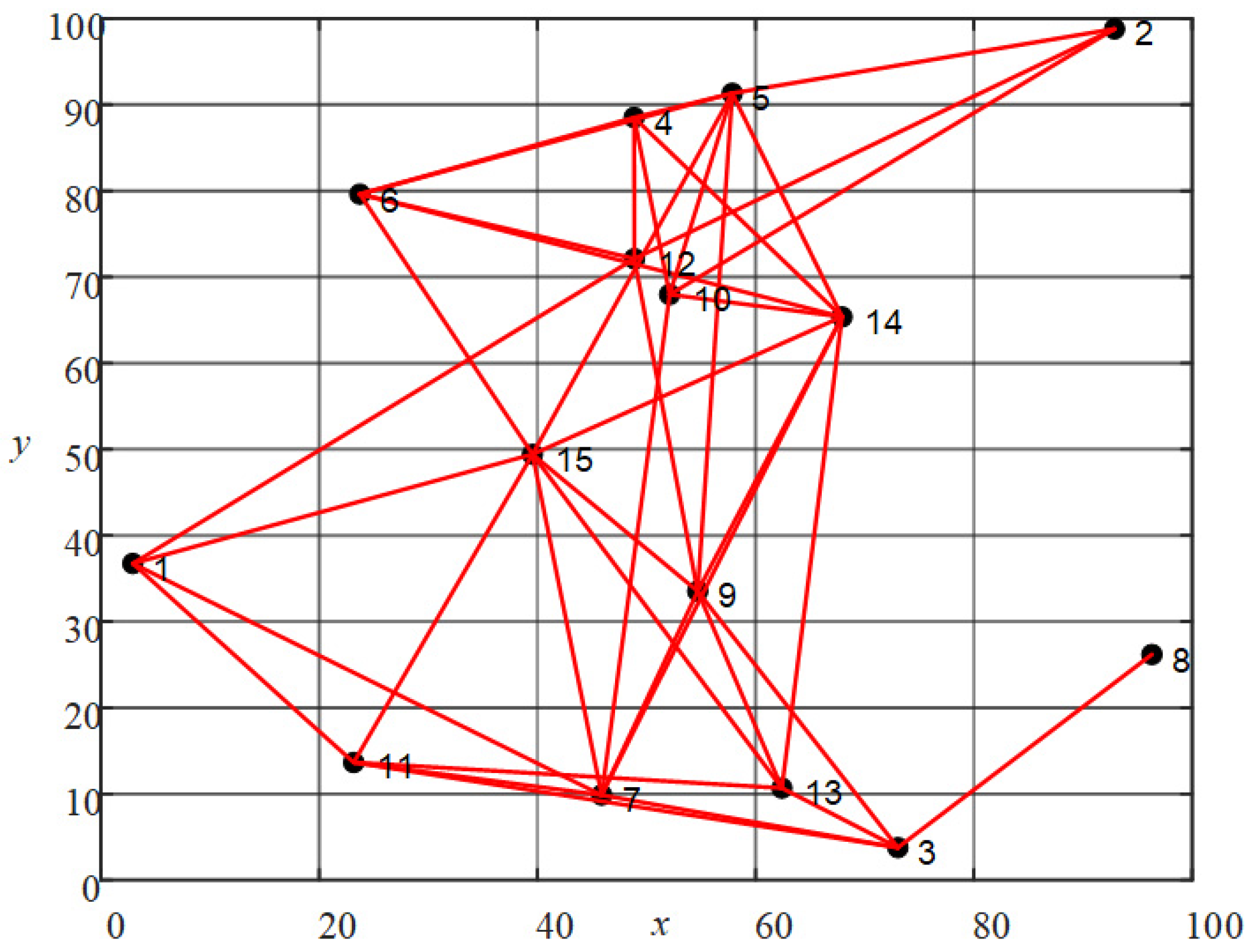
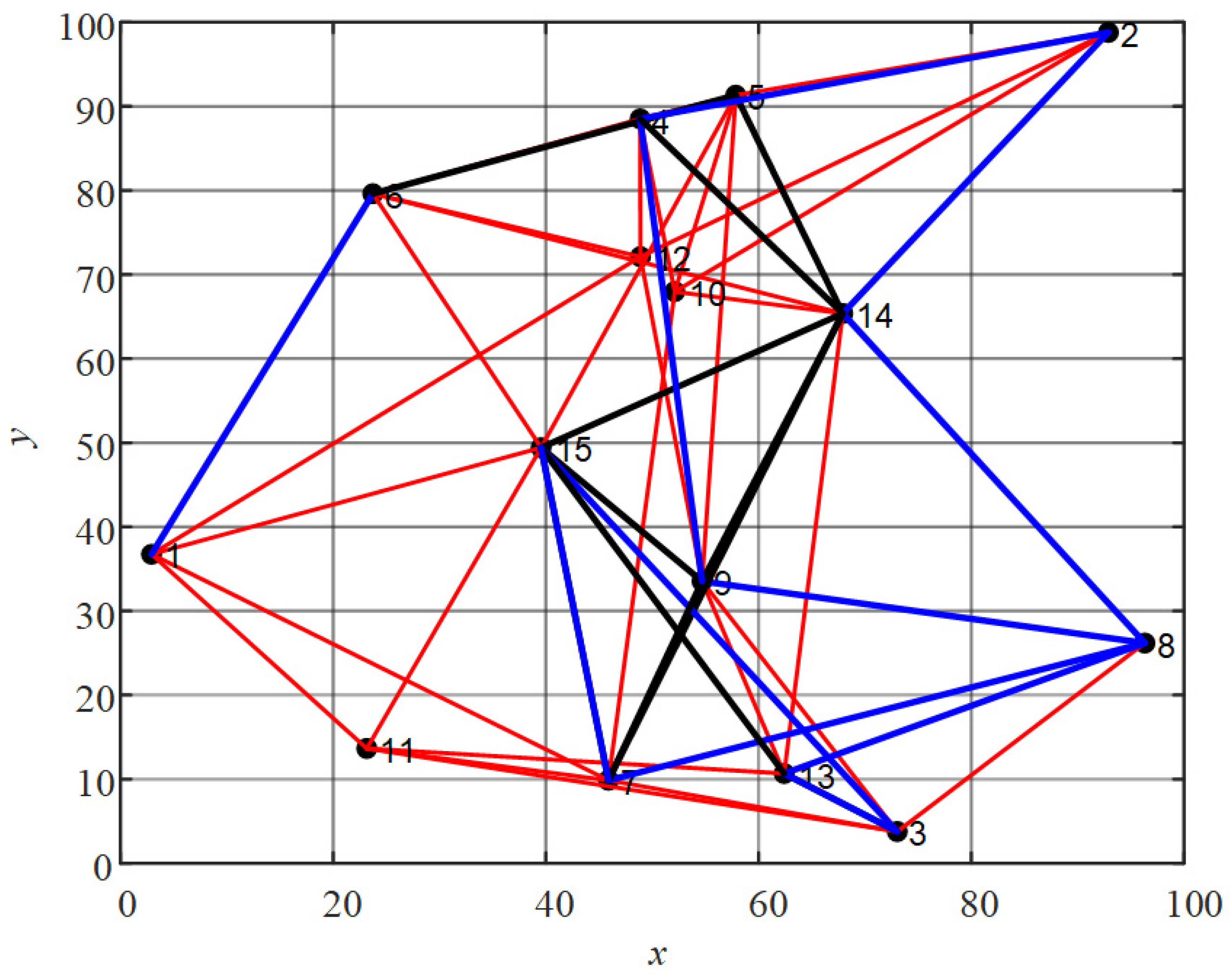
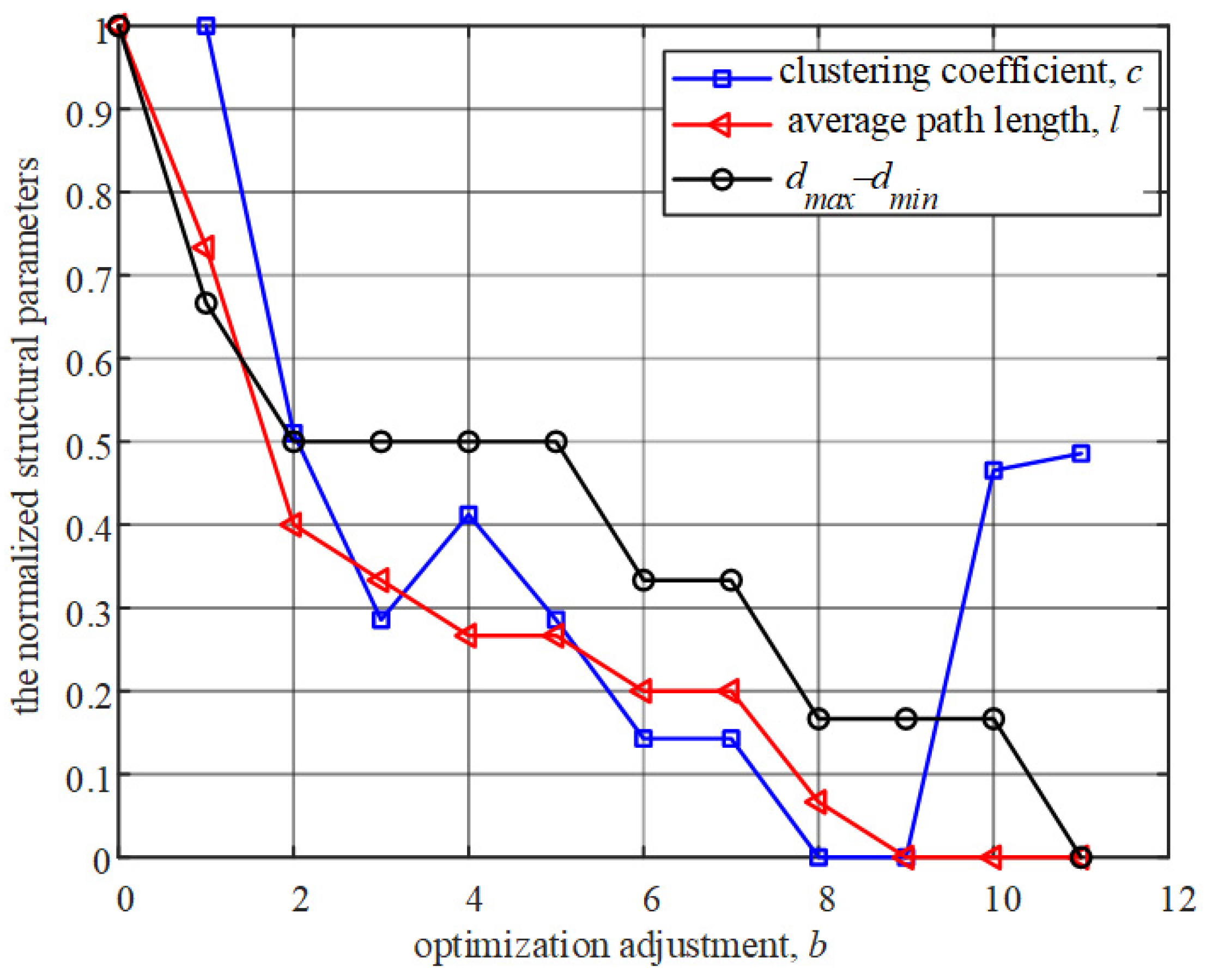
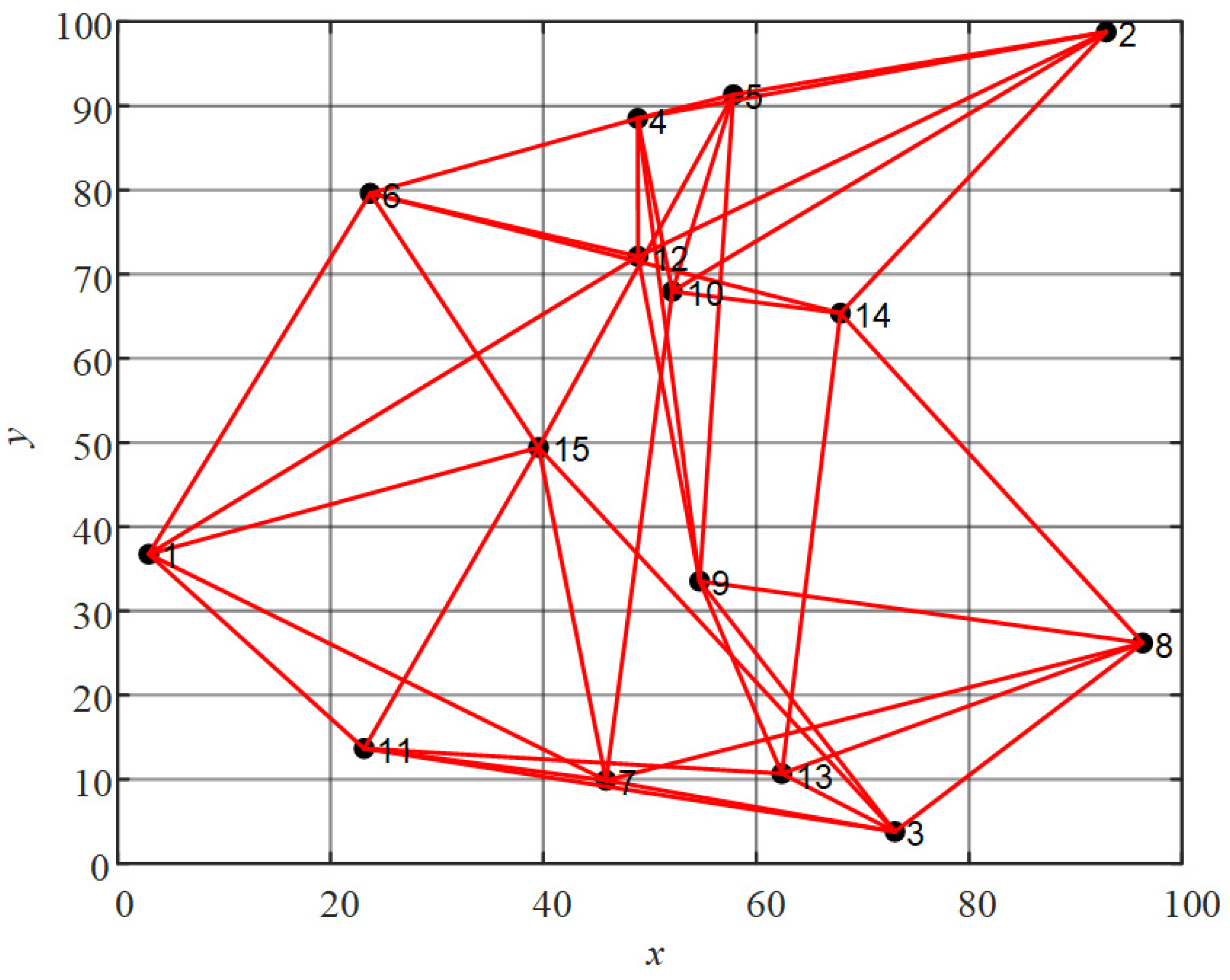

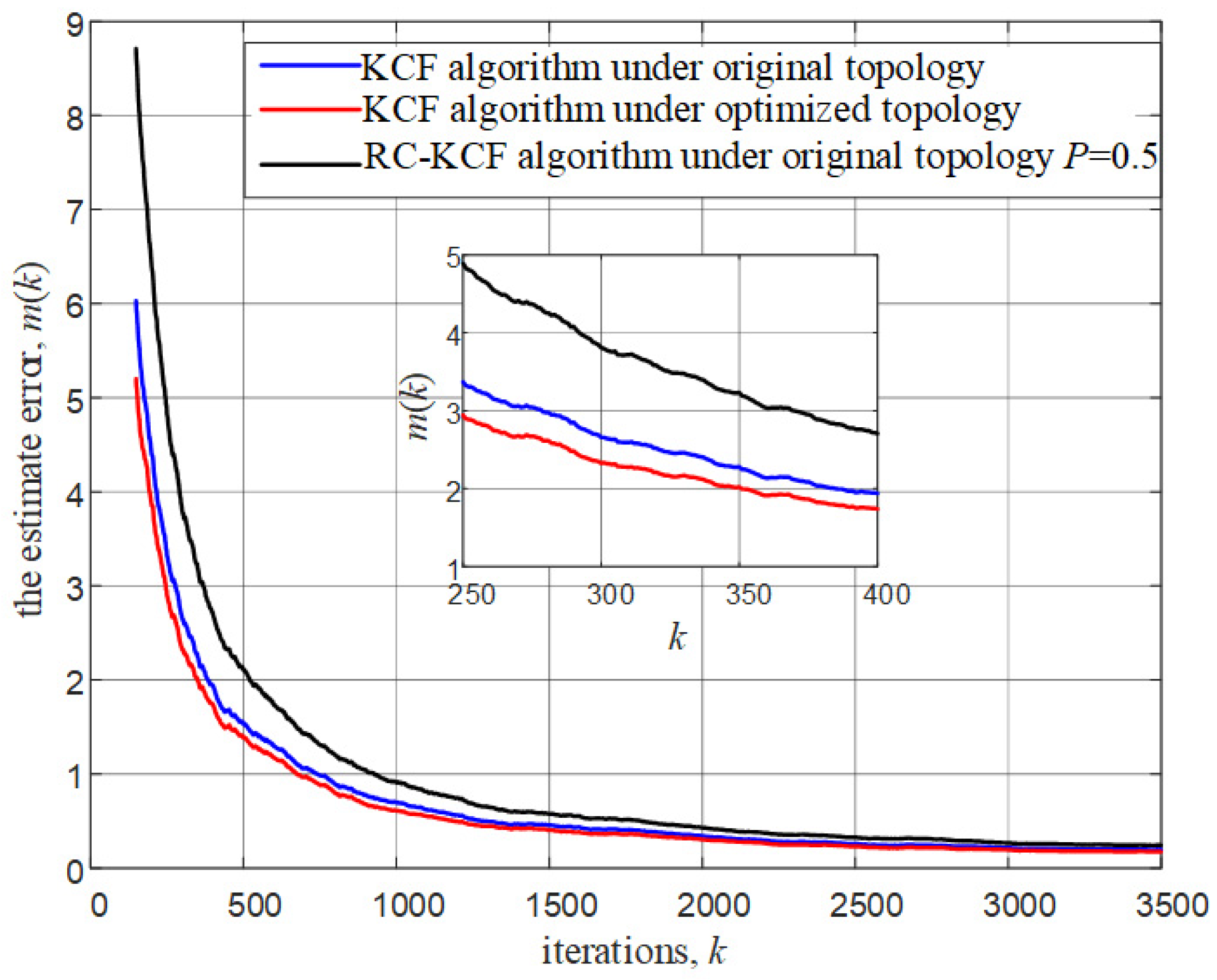
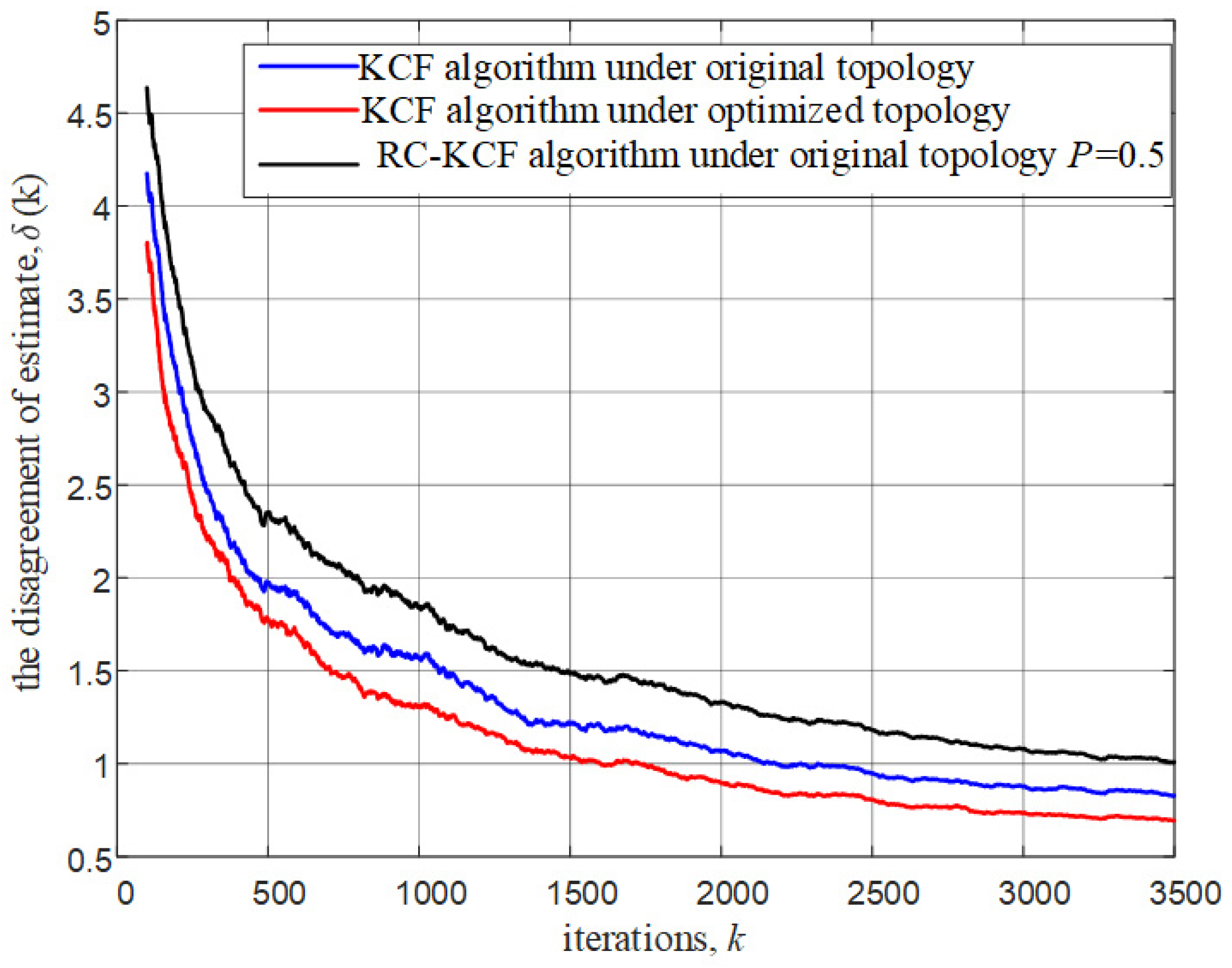
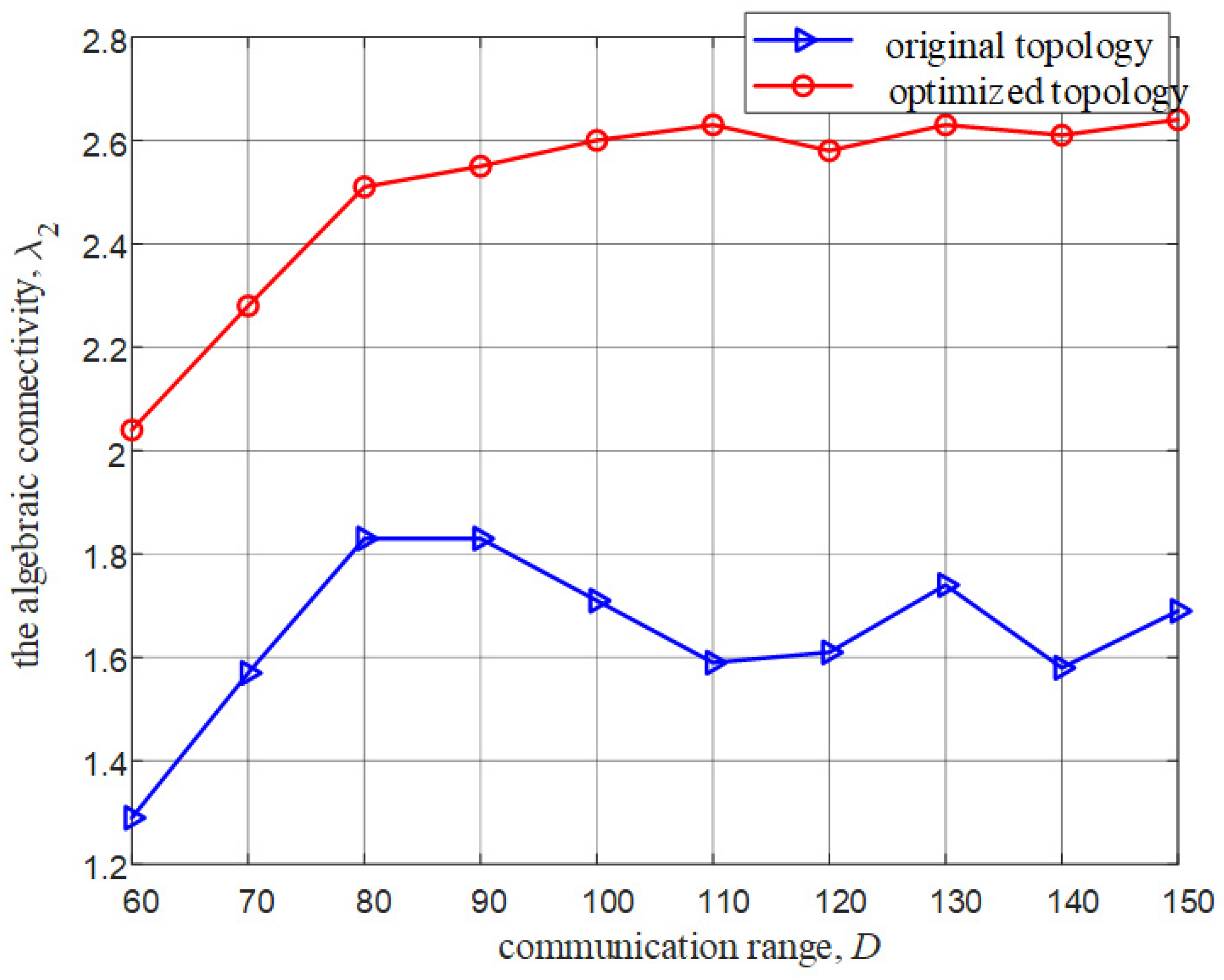
| Methods | Communication Overhead | Computational Complexity |
|---|---|---|
| The proposed method | ||
| The WWKJ method [29] |
| (P = 0.5) | ||
|---|---|---|
| 1722 | 1427 | 2779 |
| 2818 | 2194 | 4020 |
| 1669 | 1467 | 2709 |
| 1884 | 1557 | 3112 |
| 1637 | 1360 | 2773 |
| 2119 | 1914 | 3539 |
| 2418 | 1601 | 3303 |
| 2647 | 1861 | 3671 |
| 2336 | 2099 | 3986 |
| 1823 | 1596 | 2906 |
| 1857 | 1607 | 3211 |
| 1826 | 1601 | 3044 |
| 1750 | 1183 | 2492 |
| 1974 | 1301 | 3129 |
| 1819 | 1373 | 2655 |
| 1620 | 1246 | 2497 |
| 1915 | 1279 | 2828 |
| 2156 | 1799 | 3238 |
| 2345 | 1583 | 3240 |
| 1527 | 1375 | 2636 |
Publisher’s Note: MDPI stays neutral with regard to jurisdictional claims in published maps and institutional affiliations. |
© 2021 by the authors. Licensee MDPI, Basel, Switzerland. This article is an open access article distributed under the terms and conditions of the Creative Commons Attribution (CC BY) license (https://creativecommons.org/licenses/by/4.0/).
Share and Cite
Lv, L.; Chen, H.; Xie, L.; Wang, K. A Topology Optimization Method for Reducing Communication Overhead in the Kalman Consensus Filter. Appl. Sci. 2021, 11, 7107. https://doi.org/10.3390/app11157107
Lv L, Chen H, Xie L, Wang K. A Topology Optimization Method for Reducing Communication Overhead in the Kalman Consensus Filter. Applied Sciences. 2021; 11(15):7107. https://doi.org/10.3390/app11157107
Chicago/Turabian StyleLv, Lulu, Huifang Chen, Lei Xie, and Kuang Wang. 2021. "A Topology Optimization Method for Reducing Communication Overhead in the Kalman Consensus Filter" Applied Sciences 11, no. 15: 7107. https://doi.org/10.3390/app11157107
APA StyleLv, L., Chen, H., Xie, L., & Wang, K. (2021). A Topology Optimization Method for Reducing Communication Overhead in the Kalman Consensus Filter. Applied Sciences, 11(15), 7107. https://doi.org/10.3390/app11157107







